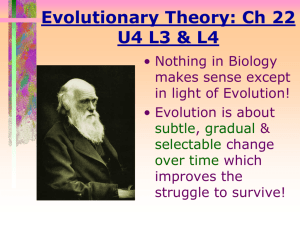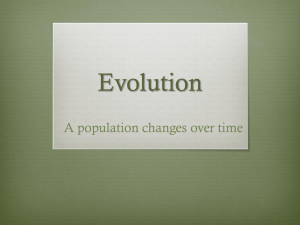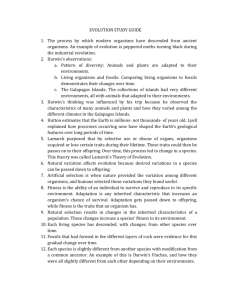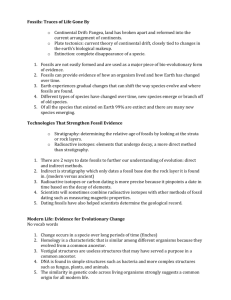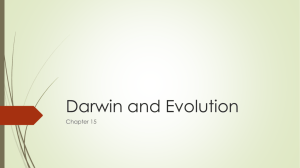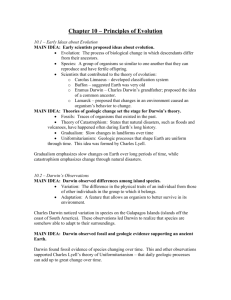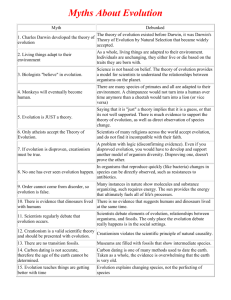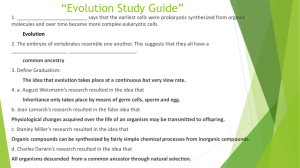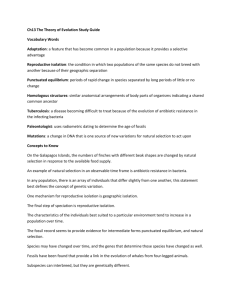Chapter Guide - Georgia Highlands College
advertisement
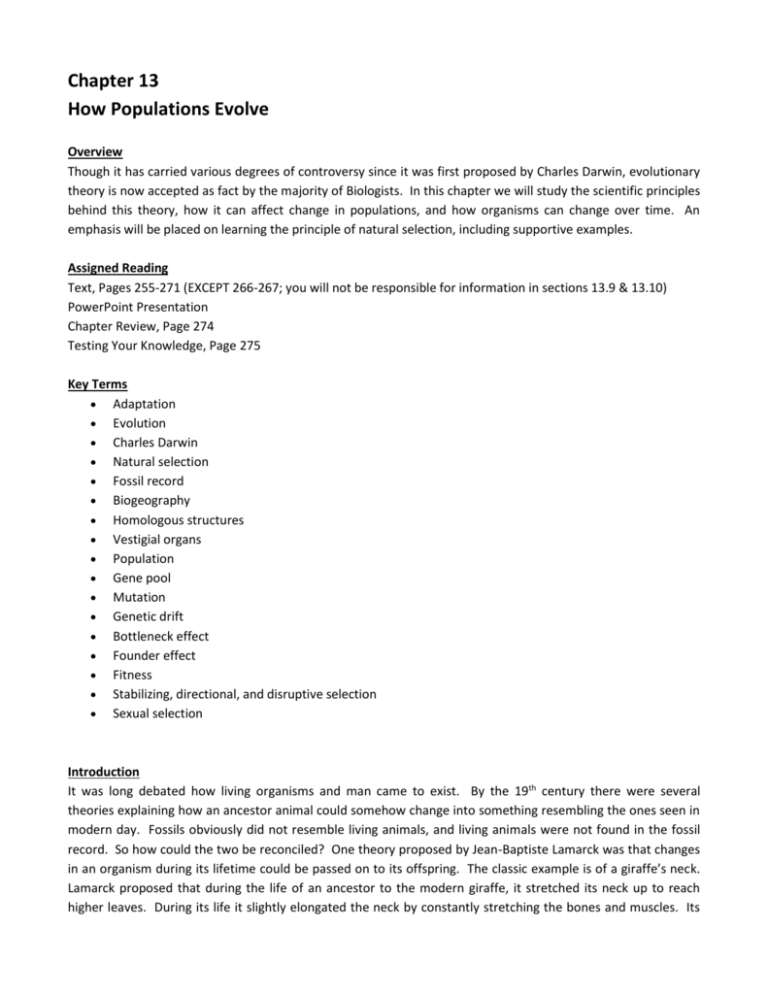
Chapter 13 How Populations Evolve Overview Though it has carried various degrees of controversy since it was first proposed by Charles Darwin, evolutionary theory is now accepted as fact by the majority of Biologists. In this chapter we will study the scientific principles behind this theory, how it can affect change in populations, and how organisms can change over time. An emphasis will be placed on learning the principle of natural selection, including supportive examples. Assigned Reading Text, Pages 255-271 (EXCEPT 266-267; you will not be responsible for information in sections 13.9 & 13.10) PowerPoint Presentation Chapter Review, Page 274 Testing Your Knowledge, Page 275 Key Terms Adaptation Evolution Charles Darwin Natural selection Fossil record Biogeography Homologous structures Vestigial organs Population Gene pool Mutation Genetic drift Bottleneck effect Founder effect Fitness Stabilizing, directional, and disruptive selection Sexual selection Introduction It was long debated how living organisms and man came to exist. By the 19th century there were several theories explaining how an ancestor animal could somehow change into something resembling the ones seen in modern day. Fossils obviously did not resemble living animals, and living animals were not found in the fossil record. So how could the two be reconciled? One theory proposed by Jean-Baptiste Lamarck was that changes in an organism during its lifetime could be passed on to its offspring. The classic example is of a giraffe’s neck. Lamarck proposed that during the life of an ancestor to the modern giraffe, it stretched its neck up to reach higher leaves. During its life it slightly elongated the neck by constantly stretching the bones and muscles. Its offspring therefore had slightly longer necks, and continued the stretching. Over an extended period of time, we ended up with modern long-necked giraffes. Darwin Charles Darwin was born in 1809. As a young man he attended college planning on becoming a clergyman. His interests and studies extended to biology, and in 1831 he voyaged around the world on the HMS Beagle as a biologist. His observations on the trip combined with his reading on current geological theories postulating an old age for the Earth led Darwin to re-think the theories of how modern organisms came to exist. By the 1850s he spoke with Alfred Wallace, another English biologist, and came to develop what we now recognize as the Darwinian theory of evolution. In 1859 On the Origin of Species by Means of Natural Selection was published, changing our understanding and discussion of biology. Evidence Evolutionary biologists can present much evidence for evolution. One of the biggest is the fossil record. Geologist and paleontologists can determine the age of fossils through radiometric dating and knowledge of the various strata and types of rocks in which fossils may be found. They have been able to determine that older fossils are simpler, having much less complexity, while more recent fossils have greater complexity. Younger fossils also show more characteristics resembling living organisms than do older fossils. Biogeography is the study of the geographic distribution of species. This field shows us that many organisms in widely varying parts of the world have very similar characteristics. African ostriches, South American rheas, and Australian emu are all large, flightless birds with very similar physical characteristics even though they are found on different continents. These similarities suggest that there was a common ancestor from which they diverged, and further suggest that at one time these ancestors lived in close proximity to each other (leading to evidence for the theory of continental drift). (Ostrich) (Rhea) (Emu) Comparative anatomy studies the similarities in specific anatomical structures between species. A widely used example is the similar bones in the forelimbs of mammals such as humans, cats, horses, whales, and bats. These homologous structures suggest a common ancestor whose populations diverged along different evolutionary lines. Natural Selection Darwin proposed gradual change over a very long period of time. These changes would occur through natural selection, a process that we often summarize as “survival of the fittest.” The basic idea is that some organisms have physical or behavioral traits that allow them a better chance of survival and creating offspring. Those offspring will be likely to have those same traits, increasing their survivability. Over time these traits become more common in a population, leading to differences from the ancestral organism. Selection can happen in one of three different ways. In stabilizing selection, extremes of a trait fail to survive, selecting for the middle characteristics. In directional selection, conditions favor the survival of one extreme to the detriment of all others in a population, slowly increasing the numbers of organisms with that trait. With disruptive selection both extremes of traits are beneficial for different reasons, causing them to increase in a population while the middle variation decreases. It is very important to realize that natural selection and evolution happen in a population, not an organism or a species. Different populations of the same species might undergo different kinds of stresses and changes that can cause them to be affected by different kinds of natural selection. Natural selection can happen because of mutations and other natural variations in phenotypes. Alterations in the DNA of an organism can lead to different expressions and characteristics. Most of these mutations are harmful and lead to death or reduced survivability. Many are neutral, giving no benefit or harm. But if some are helpful, these random changes can then become dominant in the population. Remember that these are changes in the DNA, which is inheritable. Sexual selection A specialized form of natural selection, sexual selection specifically relates to increased offspring due to advantages in choosing or keeping a mate. Natural selection often involves pressure from the environment, such as availability of food and water, heat and humidity, and other factors not directly related to reproduction. Sexual selection involves attractiveness to a mate, and has lead to various courtship displays, color patterns, and competition between potential mates. Sometimes the pressure of sexual selection can work against natural selection, leading to certain characteristics that may make survival a challenge, but make reproduction easier. Links of Interest The Institute For Creation Research Access Research Network—stories and articles related to intelligent design. The TalkOrigins Archive—Forum for discussion of topics related to evolution, intelligent design, and the debates between them. Article against intelligent design. Understanding Evolution—Articles discussing the evidence for Darwinian evolutionary theory Concepts Understand the origins of the theory of evolution and Darwin’s importance in developing it. Understand the tenets of natural selection. Understand the differences between the three kinds of natural selection. Understand the different forms of evidence for evolutionary theory. Review Material MyBiology.com—Study guides and resource for this text. Specifically look at MP3 Tutor and all Web Activities

